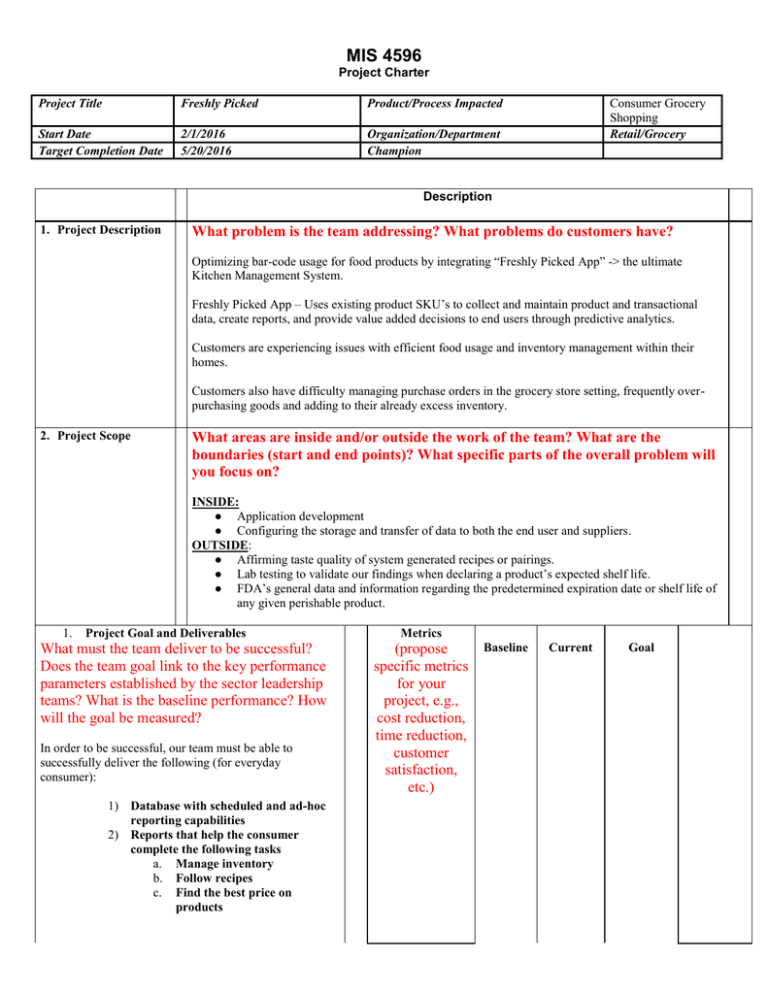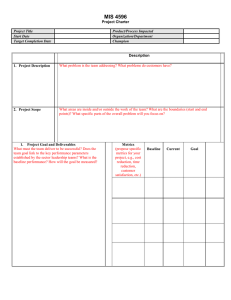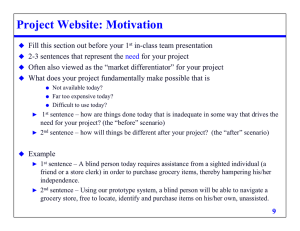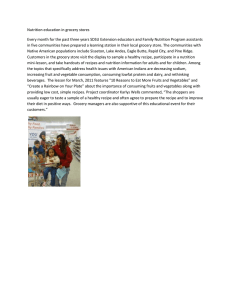Freshly Picked Charter
advertisement

MIS 4596 Project Charter Project Title Freshly Picked Product/Process Impacted Start Date Target Completion Date 2/1/2016 5/20/2016 Organization/Department Champion Consumer Grocery Shopping Retail/Grocery Description 1. Project Description What problem is the team addressing? What problems do customers have? Optimizing bar-code usage for food products by integrating “Freshly Picked App” -> the ultimate Kitchen Management System. Freshly Picked App – Uses existing product SKU’s to collect and maintain product and transactional data, create reports, and provide value added decisions to end users through predictive analytics. Customers are experiencing issues with efficient food usage and inventory management within their homes. Customers also have difficulty managing purchase orders in the grocery store setting, frequently overpurchasing goods and adding to their already excess inventory. 2. Project Scope What areas are inside and/or outside the work of the team? What are the boundaries (start and end points)? What specific parts of the overall problem will you focus on? INSIDE: ● Application development ● Configuring the storage and transfer of data to both the end user and suppliers. OUTSIDE: ● Affirming taste quality of system generated recipes or pairings. ● Lab testing to validate our findings when declaring a product’s expected shelf life. ● FDA’s general data and information regarding the predetermined expiration date or shelf life of any given perishable product. 1. Project Goal and Deliverables What must the team deliver to be successful? Does the team goal link to the key performance parameters established by the sector leadership teams? What is the baseline performance? How will the goal be measured? In order to be successful, our team must be able to successfully deliver the following (for everyday consumer): 1) Database with scheduled and ad-hoc reporting capabilities 2) Reports that help the consumer complete the following tasks a. Manage inventory b. Follow recipes c. Find the best price on products Metrics (propose specific metrics for your project, e.g., cost reduction, time reduction, customer satisfaction, etc.) Baseline Current Goal 3) Database that links multiple API’s together, bringing a holistic catalog of grocery items The team goal does coincide with the key performance parameters established by the leadership teams. The baseline performance measurements that we will track are: ● Cost Reduction ● Data Validation ● Quality Assurance ● Inventory Management Cost Reduction 50% 80% 60% Data valuation levels 80% 70% 90% Quality assurance levels 90% 50%100% 95% Inventory Management levels 50% 0%-100% 75% The goal will be measured by the differences in our data compared to each grocery store and actual shelf life. Once those differences are established and validated, our goal will be measured based on the following metrics: 1) Decrease in food waste 2) Increase of money saved in grocery stores 3) Decrease of money spend eating out We will measure these factors on a quarterly basis throughout the fiscal year. 4. Business Results Expected Our business results expected tie into how we intend to monetize the Fresh-Code App: ● ● ● 5. Team members The FDA pays for our data to ultimately strengthen their own data. Thus, improving food quality and decreasing the food based illnesses/breakouts, as well as strengthening customer loyalty for all parties. Grocery stores pay for consumer data and structure rewards programs around our data Brands will pay for preferred retailer advertising Who is this team accountable to? Who is your champion? Who is on this team? What are the specific skills/roles of each team member? Who can the team turn to for expert guidance? Team Members: ● Paul Carbone o Organization, collaboration, planning ● Anthony Massimo DeMaio o Planning, creative, execution ● Christopher Edmundowicz o Database Architect and Reporting Expert / back end configuration ● Frank Lo o Design and implementation Team Guidance/Accountable to: ● Anthony Messina ● o Instructor / Professor Mentor o TBA Team Champion: ● TBA Team Accountability: Apply IT and innovative thinking to solve a business problem. The project should solve a problem for an existing business or propose a new product or service. 6. Support Required and risks What additional resources does the team need? What obstacles does the team see, and how can they be resolved? Obstacles include regulatory compliance factors that go into maintaining quality assurance. Legal factors that go along with information gathering. Gain necessary documentation from FDA and Grocery Stores to provide proper data. 7. Customer Benefits How will this project help the customer of the organization? Could improvements have a negative impact on the customer? Consumers will realize decreased spending on groceries, less food waste, and an increased palate based on system generated recipes. 8. Technology Architecture What are the specific tools/technologies you will be using? What is the experience of team members with these tools? Resources include information on industry standards, reports, etc. Prototyping tool (JustInMind) for the application development team. 9. Overall schedule/Work Breakdown Structure (Key milestones & dates) Responsible individual Planning PC/AD Analysis PC/AD Design Implementation: Construction Implementation: Testing FL CE/FL PC/AD/CE/FL Output (notes, diagrams, interviews, screen prints) Date started if in progress Or Expected completion date Date completed or date completion is expected Installation FL/CE Charter Development Guidelines: Examples are in italics. You can expand the form to meet your requirements as you enter text. Project Title: Enter the name for your project – the name should convey a sense of purpose. Should contain an action word; such as – improve, develop, implement, reduce, etc. Reduce Cycle Time for Resolving Disability Disputes Product/Process Impacted: What you are working on. Disability Claim Process Champion: The sponsor of the project. Department Head Organization: Where you work. Corporate HQ – Shared Services Start Date: This is the first day on the project. Target Completion Date: This is depending on the negotiated time line and scope with the sponsor. 1. Project Description: Several sentences addressing: why you are undertaking this project, the magnitude of the problem, general approach to be taken and expected benefits. The Shared Services Benefits Group receives on average 30 claim appeals per month. Many of these are resolved by providing information clarifying the process and others should have been handled locally or by directly working with the service provider. This project will improve the process currently in use so that calls/claims are resolved quicker. This will allow members of this organization to focus on more strategic issues and will improve client satisfaction and eliminate re-work. 2. Project Scope: What the boundaries are of the process that you are going to be working on. This "Process" begins with opening of a claim dispute and ends when the disputed claim case being closed. 3. Project Goal: Describe the target(s) that you are planning to achieve. Reduce cycle time by 50%, reduce cost per computer installation by 50% etc. If you don’t have a quantifiable target then you cannot claim that you have reached your goal. Include the historical baseline information. The current value for the process will be updated as the project progresses toward your goal. For cycle time: Baseline- 2 days, Current- 2 days, Goal- 1 day (the goal reflects the 50% reduction from baseline) For cost: Baseline- $1000, Current- $800, Goal- $500 (the goal reflects the 50% reduction from baseline) You may have other metrics that you are working to impact; if so, substitute them for any that don’t apply. You may have only one metric and will rarely have more than three. 4. Business Results: What the benefits are to your organization when this project is complete. How will this project impact your organizations “Dashboard” metrics? What will be the impact to the financial bottom line? 5. Team Members: List the dedicated team members and also any other regular contributors to the success of the project. 6. Support Required: Identify other resources that may be required, such as outside consultants etc. 7. Customer Benefits: What the benefits are to the customers of this project if the process/product is improved. The people using the claims dispute process will get faster results and resolution of their claim. This should result in better customer satisfaction levels with the process as well as improved productivity of service operators through fewer status inquiries. 8. Technology Architecture: What are the tools you will be using (development tools, data base, etc)? How will you obtain the tools? What is the level of experience of specific team members with these tools? 9. Schedule: Enter the anticipated dates that you will complete each phase of the project; work with your champion to determine these dates.


